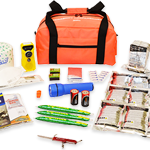Build a Kit
A disaster could leave you without power, water, heat and help.
Government and Emergency Services must prioritize the most critical needs during a major disaster, so that’s when your emergency kit will really make the difference for you and your family. At minimum, experts advise packing everything you’ll need to survive for at least three days. Ensure you’re prepared with an emergency kit in an accessible location in your home, car or workplace.

Step 1: Build or buy a kit
Either put your own kit together from scratch (use the Emergency Management BC (EMBC) list for what to put in it), or buy a ready-made kit to customize.
Be sure to choose a 72-hour kit with enough supplies for everyone in your household and consider how easy it is to carry with you if you need to evacuate. You might divide supplies into several packs so everyone can help shoulder the load.
MEMBERS SAVE
BCAA Members save 20% on select emergency kits for home and vehicle use at our Rewards Partner, F.A.S.T. (First Aid & Survival Technologies Limited). Learn more.
Step 2: Customize it
Extras to consider:
- Medications and prescriptions
- Cash – small notes
- Non-perishable food items – such as dried pasta and sauce, prepared canned soups and canned vegetables or beans
- Equipment for any family members with disabilities
- Extra clothes and shoes
- Rain and snow gear
- Toilet paper
- Feminine products
- Baby supplies like diapers and wipes
- Comfort items for children like stuffies or blankets
- Pet food (learn more about how to prepare for your pets from EMBC)
- Bar of soap and some toothbrushes
- Candy or other treats with a long shelf life
- A pack of cards or other activities
- It’s tempting to add all the things you enjoy at home, but keep in mind that you may need to carry these kits, so keep the weight manageable.
Step 3: Keep it accessible
Store your kits somewhere easily accessible. Have one in your home (near an exit is a good location), and one in your car. You could also keep one at work.
Ensure everyone in your household knows where the kits are, and which ones they’re responsible for.
Step 4: Update it annually
Emergency supplies don’t last forever. Every year make sure to check expiry dates and refresh water, food items and batteries.
Health Canada does not recommend stockpiling these items all at once. Gradually build up your storage of non-perishable food, cleaners and other household essentials by adding a few extra items to your grocery cart each time you shop. This will help ensure expiry dates for items are staggered and avoids adding pressure on the supply chain in your community.







